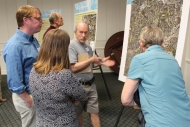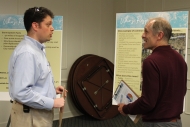A steady stream of residents filtered through the Legacy Park dining hall Wednesday night, May 1, reviewing key stormwater challenges identified during the current master planning process, and evaluating approaches for overcoming them.
Throughout the evening attendees explored content on large format display boards, then provided thoughts on a series of worksheets. Topics included the challenges of private vs. public infrastructure and who’s responsible when problems arise, stormwater trouble spots, and options for paying for necessary repairs and long-term upgrades. Neighbors brought both questions and ideas to the planning team regarding fair, effective, and innovative solutions.
Stormwater in Decatur is managed in a network of infrastructure that includes both public and private components. For the purposes of discussion, public components are those owned/maintained by the City of Decatur. Private components are those owned/maintained by a private owner or another agency. Drainage improvements on private land are privately owned and maintained, but often, solving stormwater problems requires solutions that address both publicly and privately owned parts of the system. Attendees discussed how to address privately held parts of the system to support good outcomes for neighbors, public areas, and streams.
Of particular interest to many was cost. Though specific projections are not yet possible, preliminary estimates suggest a possible price tag of $38 million in capital expenses to address the myriad concerns identified to date. Such costs, spread over a 20 year implementation window, would require the city’s current yearly stormwater fee of $100 to be increased by a factor of 5.
Would Decatur residents accept a rate increase of this magnitude? Or how about a sliding scale based on impervious coverage per parcel? Currently, single-family homes throughout the city are charged the same annual stormwater utility fee, regardless of their level of impervious surface, while commercial properties pay according to their specific impacts. Impervious coverage on single-family parcels in the city has increased by a little over 25% over the past two decades. Attendees talked about how to structure the stormwater utility fee in a way that is fair and that provides adequate funding for needed improvements.
Or, barring any rate increase above what’s presently assessed, the prospect then becomes: what projects identified and desired would need to be cut?
These are all questions yet to be resolved so your continued interest and involvement is critical. The new Stormwater Master Plan will address not only these topics, but policy issues, costs, and funding sources as well. Plus, it will identify and prioritize planned improvements based on a model of the city’s infrastructure and the extensive input received from residents about problem areas.
At the next stormwater meeting for residents (currently expected in July), criteria to rank infrastructure improvements will be a focus of the discussion. A draft Stormwater Master Plan will be available in the fall, and at that time, a public meeting will present the draft plan and seek input from residents.
Stay tuned for reminders. In the meantime, here are some photos from the evening.















